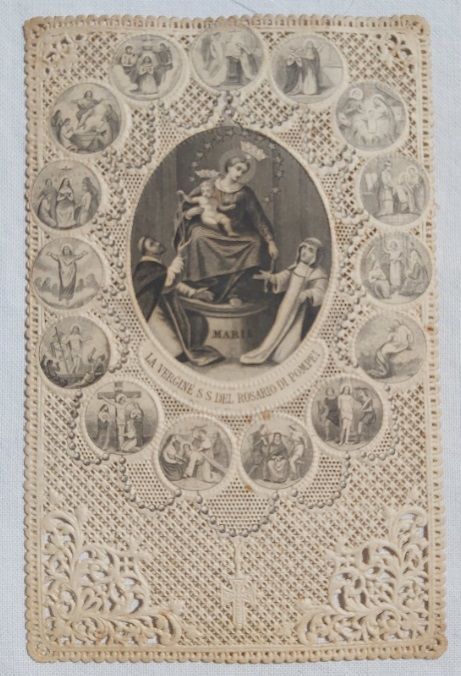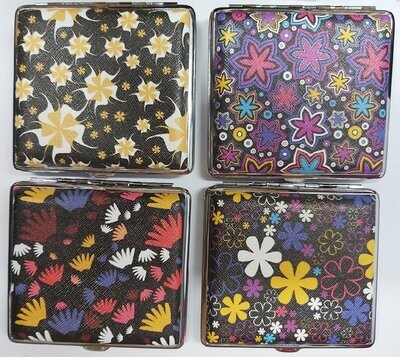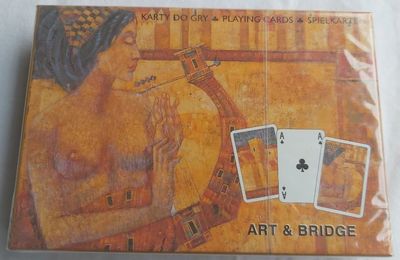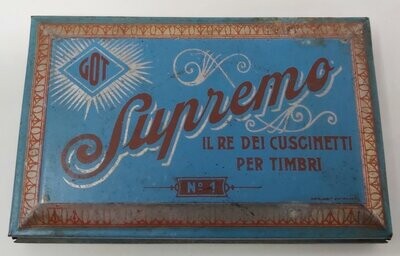Santino Holy Card Merlettato Religioso Souvenir Vergine Maria Santissima Rosario Pompei 1894
Santino Holy Card Merlettato Immagine Religiosa Souvenir La Vergine Maria Santissima del Rosario di Pompei 1894. Raro e Pregevole Santino che raffigura la Madonna Vergine Maria di Pompei con il Bambino Gesù che porgono i rosari a San Domenico e a Santa Caterina da Siena. Questa rappresentazione è racchiusa in un ovale contornato da 15 grani tondi numerati:
1 L’Annunciazione - 2 La Visitazione – 3 La Natività del Signore – 4 La Presentazione del Signore – 5 La Disputa coi Dottori – 6 Gesù che prega nell’orto – 7 La Flagellazione del Signore – 8 Gesù coronato di spine – 9 Cadute di Gesù diretto al Calvario – 10 Agonia e morte del Signore – 11 La Risurrezione di nostro Signore – 12 L’Ascensione al Cielo – 13 La discesa dello Spirito Santo – 14 L’Assunzione di Maria Vergine – 15 L’Incoronazione di Maria Vergine.
Sul retro: Orazione alla SS. V. del Rosario di Pompei – O Regina del Rosario, che avete piantato il vostro Trono di Regina e di Madre sulla pagana terra di Pompei per spargere al mondo... Dirigersi in Valle di Pompei Dall’Avv: Bartolo Longo.
Bartolo Longo (nato nel 1841 – morto 1926) è stato fondatore e benefattore del Santuario della Beata Vergine del Rosario di Pompei e consacrato alla Fraternità laica di San Domenico. Fu beatificato da papa Giovanni Paolo II il 26 ottobre 1980.
Paris L. Turgis & Fils. Imp.
Data scritta a mano: 30 gennaio 1894.
La casa editrice L. Turgis iniziò la sua attività nel 1828 al n. 16 di rue de Madama a Tolosa ed ivi rimase fino al 1853, anno in cui Jeune Turgis la trasferì a Parigi al n.80 di rue des Ercoles (ma troviamo dei santini recanti il n.60 di Rue del Ercoles). La vedova Turgis poco dopo aprì un’altra sede al n.10 di rue Serpente. Nel 1856 Jeune Turgis aprì una nuova sede a New York con la ditta J. Turgis & c. ed ivi operò fino al 1908. La Turgis cessò nel 1928.
Il biglietto di auguri e/o il santino Merlettato ha una lavorazione della carta simil pizzo, traforato. Il Merlettato si differenzia dal Canivet, che sono più ricercati e più preziosi perché fatti interamente a mano, in quanto venivano realizzati in serie mediante l’utilizzo di macchinari a pressa meccanica capace di intagliare la carta, a partire dal XIX secolo soprattutto in Francia. Inoltre, bisogna considerare tra i più ricercati anche i biglietti di auguri e/o i santini a Mezzo Punto, unici perché venivano decorati manualmente con l’aggiunta di elementi adornanti come paillettes, stoffe e metalli. Poi vi sono i biglietti di auguri e/o i santini a Siderografia su fondo trinato a punzone lumeggiato in oro.
Misure: cm 8 x 12,3.
Stato di Conservazione: ottimi condizioni con segni del tempo come da foto.
Peso: gr .
(ENGLISH)
Holy Card Lace Religious Image Souvenir The Holy Virgin Mary of the Rosary of Pompeii 1894. Rare and valuable Holy Card depicting the Virgin Mary of Pompeii with the Child Jesus offering the rosaries to Saint Dominic and Saint Catherine of Siena. This representation is enclosed in an oval surrounded by 15 numbered round beads:
1 The Annunciation - 2 The Visitation – 3 The Nativity of the Lord – 4 The Presentation of the Lord – 5 The Dispute with the Doctors – 6 Jesus praying in the garden – 7 The Flagellation of the Lord – 8 Jesus crowned with thorns – 9 Falls of Jesus heading to Calvary – 10 Agony and death of the Lord – 11 The Resurrection of our Lord – 12 The Ascension into Heaven – 13 The descent of the Holy Spirit – 14 The Assumption of the Virgin Mary – 15 The Coronation of the Virgin Mary.
On the back: Prayer to the SS. V. of the Rosary of Pompeii – O Queen of the Rosary, who have planted your Throne of Queen and Mother on the pagan land of Pompeii to spread to the world... Heading to the Valley of Pompeii From the Lawyer: Bartolo Longo.
Bartolo Longo (born 1841 – died 1926) was founder and benefactor of the Sanctuary of the Blessed Virgin of the Rosary of Pompeii and consecrated to the lay Fraternity of San Domenico. He was beatified by Pope John Paul II on October 26, 1980.
Paris L. Turgis & Fils. Imp.
Handwritten date: January 30, 1894.
The L. Turgis publishing house began its activity in 1828 at no. 16 rue de Madama in Toulouse and remained there until 1853, the year in which Jeune Turgis moved it to Paris at 80 rue des Ercoles (but we find some holy cards bearing the 60 Rue del Ercoles). The widow Turgis shortly afterwards opened another branch at 10 rue Serpente. In 1856 Jeune Turgis opened a new office in New York with the firm J. Turgis & c. and operated there until 1908. Turgis closed in 1928.
The Merlettato greeting card and/or holy card has a lace-like, perforated paper process. The Merlettato differs from the Canivet, which are more refined and more precious because they are made entirely by hand, as they were made in series using mechanical press machinery capable of carving paper, starting from the 19th century especially in France. Furthermore, greeting cards and/or holy cards in Mezzo Punto must also be considered among the most sought after, unique because they were decorated manually with the addition of adorning elements such as sequins, fabrics and metals. Then there are the greeting cards and/or holy cards in siderography on a laminated background with a punch highlighted in gold.
Measurements: 8 x 12.3 cm.
State of Conservation: excellent condition with signs of aging as shown in the photos.
Weight: gr.
La Gaudium di Pietro Ciancia è una ditta individuale fornitrice di carte da gioco per circoli, associazioni, centri anziani, ludoteche. Commercializza tarocchi e carte per la cartomanzia e per la divinazione.
Nel sito sono presenti mazzi rari e fuori produzione, per collezionisti ed appassionati.
I contatti con numerosi antiquari permettono alla Gaudium di approvvigionarsi in modo costante di oggetti antichi, vintage e curiosi. Moltissimi di questi oggetti sono stati dati a noleggio alla produzione Rai e Mediaset per film e fiction.
Infine la Gaudium offre il Servizio di Assistenza e Riparazione Pipe e Accendini.












